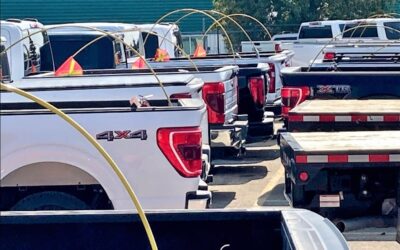Top 8 Ways to Reduce Fleet Fuel Spend
Although fuel prices are currently dropping, the overall fuel cost for a fleet is often at the forefront of concerns for fleet management. Why? According to Ron Katz of Chevin Fleet Solutions, “[fusion_builder_container hundred_percent=”yes” overflow=”visible”][fusion_builder_row][fusion_builder_column type=”1_1″ background_position=”left top” background_color=”” border_size=”” border_color=”” border_style=”solid” spacing=”yes” background_image=”” background_repeat=”no-repeat” padding=”” margin_top=”0px” margin_bottom=”0px” class=”” id=”” animation_type=”” animation_speed=”0.3″ animation_direction=”left” hide_on_mobile=”no” center_content=”no” min_height=”none”][Fuel spend] accounts for around a third of a fleet’s operating costs and… is a major consideration for many operations.”
Luckily, there are several ways to manage and lower fleet fuel costs including these top eight: conduct regular preventative maintenance (engine, tire and wheel), right size the fleet, manage fuel usage, improve vehicle weight, optimize routes, monitor idling, improve driver behavior, and educate entire company on best fleet practices in reducing fuel spend.
#1 Conduct Regular Preventative Maintenance – Engine and Tire
Proper preventative maintenance (PM) ensures that your fleet vehicles will run effectively and efficiently. It is recommended to check your vehicles every one to three months for optimal performance, especially in the fuel area.
Getting regular oil changes, along with using the manufacturer’s recommended grade of motor oil, can lead to better fuel efficiency. According to Vincent Raynor, Director Strategic Consulting at Element Fleet Management, “Lower oil viscosity requires less energy to circulate through the powertrain of the vehicle, leading to improved fuel economy.” The less friction in your engine, the better the fuel savings.
Proper tire and wheel maintenance can also help cut fuel costs. Maintaining appropriate tire pressure is key. Be sure to check your tire pressure regularly, as every one psi (pounds per square inch) drop can result in lower gas mileage by 0.4%.
#2 Right Size Your Fleet
Another way to cut fuel costs in your fleet is to ensure you are using your fleet appropriately: using vehicles that fit your needs and/or reducing your fleet numbers all together.
Consider replacing older vehicles with newer ones that have smaller engines and weigh less, thus improving the fuel economy.
#3 Monitor Fuel Card Usage
Does your fleet use a fleet fuel card system? If not, you may want to consider such a system. If you’re currently using a fuel card system, be sure to manage them appropriately by monitoring purchase activity. This can help to identify theft in the system.
Be sure to meet with your drivers to review past fuel expenses – it is important to hold your employees accountable for their buying activities. Typically, when employees know they are being monitored and will have to report their expenses on a regular basis, fuel costs tend to decrease.
Receiving real-time fuel purchase notifications can also help to curb overspending on fuel. Look to receive level III data from your fuel card system. This data includes more detail on every transaction including odometer, vehicle ID, driver ID, and PIN.
#4 Improve Vehicle Weight
The weight of the vehicle itself, is not in question here – what’s placed in or on the vehicle that adds to the overall weight is the key.
Be careful not to unnecessarily overload your vehicle, as it can decrease fuel efficiency. Items like tools and tool boxes, ladder racks, bed covers, body boxes, bumper guards, and stake beds can really weigh a vehicle down. If any of these items are not necessary, remove them from your vehicles.
Katz of Chevin coincided by reporting that “…an extra 100 lbs. in a vehicle could reduce its mpg by almost 1%.” That is significant!
#5 Optimize Driving Routes
This is almost a no-brainer for better fleet management. Taking a longer route to the destination will almost always cost more in gas. Planning your route prior to hopping in the driver seat, can save considerable money on gas. This is where a good GPS device or in-vehicle program comes into play.
Not only can GPS help to optimize your route to reduce unnecessary miles, it can also assist in tracking a driver’s personal use versus official work use. Some drivers are allowed to use the company vehicle for personal use but need to pay for the fuel, which can help an organization’s expenses.
Additionally, using GPS can assist in locating drivers closest to the fleet’s next project. Why reach out to drivers who may be further from the project site, when a closer driver will save significantly on fuel spend?
Related: The Benefits of Fleet Telematics
#6 Reduce Vehicle Idling
One of the biggest offenders of high fleet fuel spend is idling, and telematics can help control this offender. With the use of GPS, fleet management can easily view which vehicle has been idling, for how long, and where it was idling. The fleet manager can then assess why the vehicle was idling and discuss ways to reduce idle time with the driver.
Did you know that an idling vehicle can waste up to half a gallon of gas per hour? That’s significant. Ron Katz shared that “Anything over 30 seconds of idling uses more fuel than turning off and restarting a vehicle.”
By using GPS and telematics data, changing “idle behavior” can be easy for managers.
#7 Improve Driver Behavior
Driver behavior can make a big impact on fuel spend. What the U.S. Department of Energy deems as “aggressive driving,” can reduce fuel efficiency on the highway by as much as 33% and city efficiency by 5%.
Aggressive driving is defined as harsh braking, speeding, and rapid acceleration. By going the speed limit and avoiding other aggressive driving tactics, your drivers can help to reduce fuel costs.
#8 Educate Entire Company on Best Fleet Management Practices
It is important that the entire company understand and buy-in to best fleet management practices, specifically reducing fuel costs. The “entire company” consists of everyone including the company stakeholders down to the fleet drivers.
Begin with proper training and education about the best fleet management practices. There are training courses available online that your team can complete during their downtime. And of course, the policies they learn must be regularly enforced.
Andy Hall, Assistant Manager at ARI, agrees with the idea of entire company buy-in. “You can’t enforce what doesn’t exist. Begin by developing a written policy that clearly defines your company’s fuel management policy and be sure your drivers are aware of it,” Hall suggests.
Try all, or at least some of these strategies, for reducing your fleet’s fuel costs.
Sources:
https://summitfleet.com/guide-reducing-fleet-fuel-costs/
https://www.automotive-fleet.com/channel/fuel-management/article/story/2017/05/top-10-strategies-to-reduce-fuel-spend.aspx[/fusion_builder_column][/fusion_builder_row][/fusion_builder_container]






